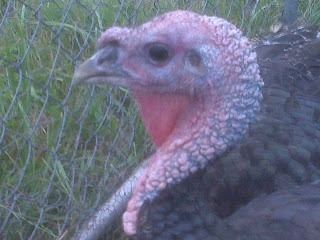
I posted once before that there is not nearly as much on line about raising turkeys as there is about raising chickens. So, as best i can I'm going to chronicle what we've done so far.
Now, remember, this is my first shot at Turkey's so all I have to go on is what I've done this year. You'll have to take it for what it's worth.
I ordered the poults (baby turkeys) in April. I ordered them to arrive the week before the Memorial Day weekend, but that didn't happen. They arrived the first week in June. I ordered a straight run, that is, males and females. Normally, when I order the chickens, I order only cockerels (males). I have to admit that the one thing that bothers me about raising poultry is that everyone orders cockerels for meat birds. They have a better chance of growing large quickly. But what do they do with the females that are born? Well, if no one wants them for layers, they are destroyed. It just seems like a colossal waste. So, I ordered a straight run for the poults.
I raise chickens for meat, too, so it made sense to order them together. I ordered 70 chickens and 10 turkeys. So, again, logistically it didn't make sense to build a second brooder and double the effort of feeding, watering, and heating. Here's where the debate comes in.
Traditional farmers say that you cannot, under any circumstance, combine chickens and turkeys'. There is a disease, the Blackhead, that chickens carry but are immune to. For turkey's, however, it's most often fatal. so the solution is to separate them at all cost. Farmers that tend toward the organic methods say it's okay to leave them together, at least when they are small. Then comes the debate on how long to leave them together. And on the debates go. I had a chance to participate in Joel Salatin's Farm Days a couple years back. They keep chicks and poults together and the mortality rate was surprisingly low. So my logic goes something like this. Joel Salatin does it...good enough for me.
When we first got them home, I set a few chicks in the brooder and let them acclimate for a few minutes. Then I mixed in the poults. I read that it's wise to dip the beaks of the poults in the water to initiate them to the brooder. Apparently they have a harder time acclimating. I followed this practice. I have no idea whether or not it made a difference. I have also read that the chicks are able to "teach" the poults how to find food and water. Again, I can't vouch for the legitimacy of that statement, but we had no issues with poults not finding food and water. So something worked.
And so they lived communally for about two weeks. I was surprised to see that at the end of two weeks, the poults were able to easily fly out of my 2 foot high brooder. If you're going to brood them that long or longer, I would suggest either a 3 foot high brooder, or the use of a lid. I will add that 2 feet in no way cramped them. There was still plenty of height. The addition of a lid is only required to keep them from flying out. During this time, I also fed the chicks and poults the same ration. Of course turkey's require a ration higher in protein (28% to start with), but again, it would be an addition to the process to feed them separate feed from separate feeders, and so on. I opted to feed them the same ration. It didn't seem to impede them at all.

After the two weeks, we brought them out to pasture. I separated the chickens from the turkeys Now the ten poults had their own place. I also switched them to the Turkey Starter ration. I placed the pens close to one another. I have been warned that they need to be kept far from one another, but again, the process dictated that they can't be too far apart. If they are, I lose valuable time in moving from one place to another. So they are about seven feet from one another.
They are twelve weeks old as I write this post. They must be about 10-12 pounds apiece. We had a major wind storm that you can read about here, but we didn't lose any of them. Thus far, disease has been non-existent. Predators have not posed a problem. They are growing really very well. I've switched to a grower ration with a 25% protein ration. It's pelleted, cheaper, and more efficient for them at this time. I still mix in the Fertrell Nutri-Balance which you can read about here.

Now, fair warning. They are aggressive. I try to incorporate my children into all the things I do with the poultry. In this case, they are not allowed to go in the Turkey pen unless an adult knows about it. The children are all 10 and under so it's very possible a turkey could fly up and spur them in the face. That said, we've had no injury thus far to either friend or fowl. We take it seriously. We have fun (for sure) but we know that the birds are living and must be treated with respect.
So that's what I have for now. I'll keep you posted on how the rest of this little experiment goes. Lord willing, we'll have Turkey from our own pasture to be thankful for this November.
Mmmmm....I can smell it now.....

No comments:
Post a Comment